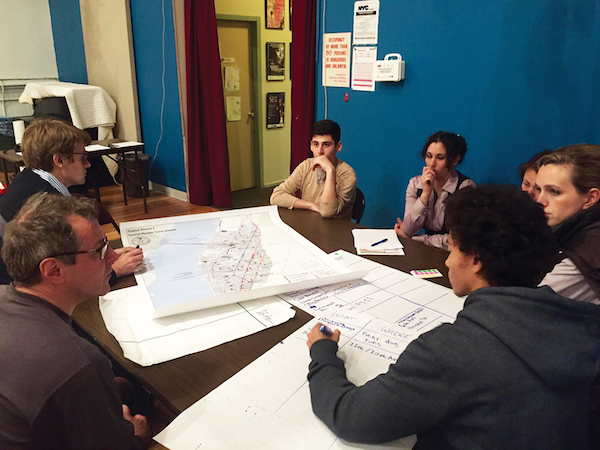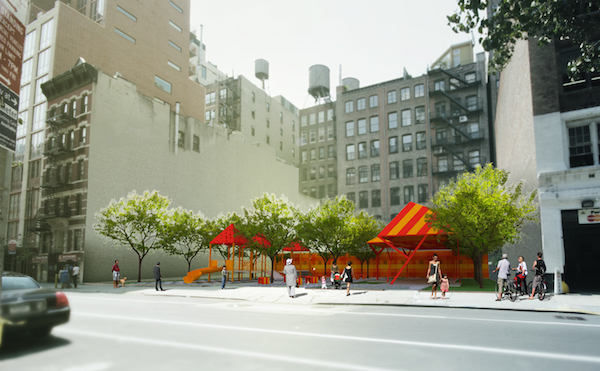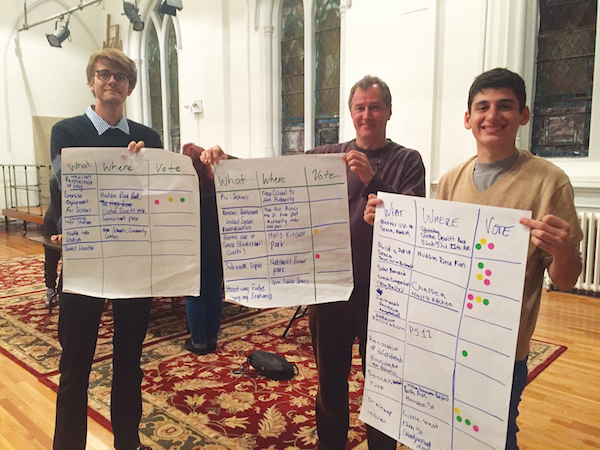
BY YANNIC RACK | What if you could step into the shoes of local legislators and decide what improvement projects to greenlight for your neighborhood? That possibility is becoming real, once again, as the Participatory Budgeting process kicks off — after last year’s inaugural effort awarded funds to, among other things, a new park on W. 20th St. and an ADA [Americans With Disabilities Act]-compliant bathroom for Jefferson Market Library.
About $1 million is up for grabs in Council District 3, which along with Chelsea and Hell’s Kitchen also includes the West Village and parts of Flatiron, Soho, and the Upper West Side.
“We want to know what the needs are in the district, and how Participatory Budgeting can meet those needs,” Matt Green, an aide to District 3 Councilmember Corey Johnson, recently told a group attending a neighborhood assembly at New Dramatists (on W. 44th St.), one of several held throughout the district to introduce residents to the concept.
Participatory Budgeting is a grassroots process that lets community residents vote to directly allocate money toward proposals developed to meet local needs. Through a series of public meetings, they work with elected officials throughout the year to identify neighborhood concerns and craft proposals to address them. Residents then decide which proposals to fund through a public vote.
Anyone who lives or works within the district can volunteer to become a budget delegate, which means they will join a committee advocating for one of the projects, with regular meetings scheduled through next spring.
The proposals will then be submitted to Corey Johnson’s office and reviewed by the responsible city agencies some time in late January or early February. Green said the agencies would then come back with cost assessments and feedback on the individual projects.
The final ballot will go to a public vote in late March or early April. Anyone, even undocumented immigrants, can vote as long as they live in the district, and are at least 14 years old. The winning ideas will be adopted into the city’s budget in June.
“Then it can take a number of years for them to be implemented,” Green said, noting that although no projects chosen during April 2015’s final voting process have broken ground yet, the funding would not be lost.

At the meeting in Hell’s Kitchen, around a dozen residents brainstormed in small groups to come up with a new slate of viable projects. Half of them had been at a launch event on the High Line organized by Johnson a few days earlier, but only a few had taken part in the process last year.
“I think it’s a worthwhile cause,” said Carrie Smith, 41, who found out about the event through a newsletter sent out by Johnson’s office. Smith lives on W. 42nd St., between Eighth and Ninth Aves., and said she came to propose some kind of street beautification project, like planting trees and adding a roundabout or a public bathroom on her block.
“I care about the condition of my neighborhood,” she said. “I don’t think that, just because it’s a major thoroughfare, that’s an excuse to have a really disgusting block, where I smell human feces and urine every single day on my way home.”
Last year, around 2,400 people voted for their favorite projects in the district.
One of them was Susan Treacy-Mannix, 49, who lives in the Manhattan Plaza complex on W. 43rd St. She said she had found out about the process too late to actively participate last time, and had come to the meeting to advocate for a library at the new City Knoll Middle School on W. 33rd St., where one of her sons attends seventh grade.
“We need it, we need it for these kids. These kids that don’t have anything, they can’t continue because there’s no resources for them. If we can get this middle school up and running it will benefit everybody,” she said.
“Downtown had everything, then they got hit by Sandy, and got it again. We never had anything to begin with [in Hell’s Kitchen], and this goes back a long time. That’s why I want this library.”
Treacy-Mannix, who sits on the school’s PTA, said she might even decide to volunteer as a budget delegate if she can find the time.
Green said that the district had 55 delegates last year, with a few assigned to each of the 17 projects on the ballot, of which seven were eventually selected.
The total funding pledged in the district’s first round came to $1.68 million, with individual projects ranging from as little as $35,000, for library renovations at PS3, to as much as $500,000, for the Jefferson Market Library project.
The costliest idea was actually renovations for the bathrooms at Lab School, running to $560,000, but the NYC School Construction Authority is funding that project — showing how Participatory Budgeting can raise awareness for community improvements even beyond the program’s own resources.
At the meeting, Green also emphasized that this was an opportunity for residents to bring attention to what they think needs fixing in their community, whether the projects will eventually be chosen or not.
“We want to expand civic engagement,” he said. “The best ideas come from the residents who interact with their physical environment every day.”
This year, New Yorkers in 27 Council Districts will collaboratively decide how to distribute over $30 million to local capital projects. Each idea must cost between $35,000 and $1 million to be viable.

Patrick Shields, 52, was at the neighborhood assembly with his mind already made up. Like Treacy-Mannix, he had come with a particular proposal: to replace the tar surface at the William F. Passanante Ballfield on W. Houston St. with a proper soccer turf.
Shields was a budget delegate last year, but his pet project, funding another soccer turf near the Fulton Houses on W. 17th St., wasn’t selected. As a longtime resident of the West Village who only recently moved to Manhattan Plaza in Hell’s Kitchen, he said that, by sprucing up unused playgrounds, they could be preserved from development in the future.
“I want to get as much soccer turf anywhere I can, because those actually get used. Passannante Park is empty constantly,” he said.
The last initial information session on the Participatory Budgeting process will be a youth assembly held on Oct. 29 at the LGBT Community Center on W. 13th St. Green said that a website with this year’s proposals for Council District 3 would be launched soon. In the meantime, visit coreyjohnson.nyc for the latest on this and other District 3 concerns.
As for the stated goal of fostering civic engagement, it seemed the residents at the community assembly were taking it to heart. Between the three groups, they came up with a multitude of different ideas, ranging from bike lanes on W. 14th St. and a pop-up business space in Hudson River Park, to sidewalk repairs and solar-powered trash compactors throughout the district.
Shields’ project, the soccer turf on W. Houston St., also garnered wide support, and he said he had learned from last year’s budgeting process.
“I’m going to work really hard to get out the vote on this one,” he said.
































